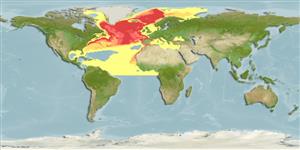Common names from other countries
Environment: milieu / climate zone / depth range / distribution range
Sinh thái học
Tầng nổi; Mức độ sâu 0 - 1453 m (Ref. 122879). Temperate; 90°N - 0°S, 180°W - 180°E
Atlantic Ocean, Arctic and the Mediterranean. Temperate to Subarctic.
Length at first maturity / Bộ gần gũi / Khối lượng (Trọng lượng) / Age
Maturity: Lm ? range ? - ? cm Max length : 980 cm TL con đực/không giới tính; (Ref. 1394); 870 cm TL (female)
Found in deep waters, mostly seaward of the continental slope. Feeds on squid, fish, sea cucumbers, starfish, and prawns on or near the bottom (Ref. 1394). Maximum depth recorded lasted for 70.5 minutes (Ref. 122879). Found in deep waters, mostly seaward of the continental slope. Feeds on squid, fish, sea cucumbers, starfish, and prawns on or near the bottom (Ref. 1394).
Jefferson, T.A., S. Leatherwood and M.A. Webber. 1993. (Ref. 1394)
IUCN Red List Status (Ref. 130435)
CITES status (Ref. 108899)
Human uses
Các nghề cá: Tính thương mại
FAO - Các nghề cá: landings, species profile | FishSource | Biển chung quanh ta
Các công cụ
Thêm thông tin
Age/SizeSự sinh trưởngLength-weightLength-lengthHình thái họcẤu trùngSự phong phú
Các nguồn internet
Estimates based on models
Preferred temperature
(Ref.
115969): -0.9 - 4.4, mean 3.2 (based on 712 cells).
Vulnerability
Very high vulnerability (90 of 100).
Price category
Unknown.
